Van Driving Toolkit







With more than 4 million vans registered in the UK, it is a common misconception that there is no legislation governing van drivers and van operations. Due to their size and weight, vans can be driven and used for anything – right?





Wrong, in fact very wrong. With an increase of roadside stops for vans and the average fine per offence in the region of £972, it doesn’t take long for van drivers and owners to figure out that vans which don’t comply with the rules, regulations, standards and procedures can be a costly experience in fines, let alone additional costs for recovery and repair.
To help with making our roads safer and more pleasant places to travel on, a series of driver information cards have been produced to assist van drivers and fleet operators in dispelling uncertainty and myth, and implementing best practice for what is required to reduce costs, improve operating conditions and ensure safe and legal vehicles and wellbeing for drivers at all times.
These are just some of the legislation and governing bodies keeping van drivers and fleet operators safe and legal on our roads. Do you know what your responsibilities are?
• The Road Vehicles (Construction and Use) Regulations 1986
• Corporate Manslaughter and Corporate Homicide Act 2007
• The Driver and Vehicle Standards Agency (DVSA)

• The Driver and Vehicle Licensing Agency (DVLA)
• The Health and Safety at Work Act 1974
• Road Vehicles Lighting Regulations
• The Traffic Management Act 2004
• The Department for Transport (DfT)
• Health and Safety Executive (HSE)

• Traffic Commissioners
• Road Traffic Act 1988
• The Highway Code
• National Highways
• EU Drivers’ Hours
• The Home Office
• Local Authorities • Domestic Drivers Hours Rules • Police Forces
• Driving without the correct entitlement to drive may result in a driver being issued with 3-6 penalty points and a fine of up to £1,000.
• Penalty points are not displayed on the driving licence photocard.
• Drivers who accrue 12 penalty points or more on their licence within 3 years will be disqualified from driving for 6 months. However this can be longer if they have had a previous disqualification within 3 years.
• Drivers can have their licence revoked (withdrawn), if they build up 6 or more penalty points within 2 years of passing their driving test.
Driving licence categories explain what vehicles a driver can drive. Each category of vehicle is represented by a letter or a letter and a number. In total, there are 26 driving licence categories. They can be found on the back of the driving licence.
Driving licence information/ restriction codes, also found on the back of the driving licence specify what conditions must be met to drive a vehicle. There are around 50 driving licence codes.

• Always keep your driving licence safe and whenever possible, carry it with you when driving.
• Know your driving licence number.
• Know what categories of vehicles you are entitled to drive.
• Know what endorsements and penalty points are on your driving licence.
• Drivers with a photocard driving licence can view their driving licence record and details of penalty points and the time remaining until they expire, online at www.gov.uk at any time.
If a driver passed their test before the 1st of January 1997, they are usually permitted to drive a vehicle and trailer combination up to 8,250kg Maximum authorised mass (MAM).
If a driver passed their driving test on or after 1 January 1997, they are permitted to tow trailers up to 3,500kg MAM.


Where an offence has been committed, a penalty code will stay on the driving licence record for a number of years depending on the seriousness and circumstances. Generally, the length of time they stay on the licence record ranges between 4 and 11 years. Penalty points will be removed automatically once the period has expired.

• A driver’s ability to drive in GB on a foreign driving licence depends on the length of their stay and the country where their licence was issued.

• Non-GB driving licences can be registered using a D9 form or exchanged using a D1 application form from DVLA.
• Visit www.gov.uk and search for ‘driving licence non-GB’.
Drivers are not required to take any driving lessons in GB before taking the test.
Drivers with a non-GB provisional licence must apply for a provisional UK licence to drive in the UK. They can then take the test after 6 months.
If the licence was not issued in the EU or a designated country, drivers can drive any category of small vehicle up to 3,500kgs in GB on their original full, valid licence for 12 months. They will then need to apply for a GB provisional licence and pass the UK practical test.
Drivers holding a full licence issued within the European Union can drive in GB using their original licence until it expires and there is no need to exchange it or retake a driving test. The driving licence will expire when the driver turns 70, which is when the licence must be exchanged.

The same applies to those drivers with a European Economic Community (EEC) licence. The European Economic Area comprises all members of the European Union, as well as Iceland, Liechtenstein and Norway.

Drivers from a ‘designated country’ can drive in GB for up to 12 months on their licence. After this period, they must exchange their licence to keep on driving. It can be exchanged up to 5 years after becoming a UK resident (if not expired) without having to retake a driving test. Designated countries are Australia, Barbados, British Virgin Islands, Canada, Falkland Islands, Faroe Islands, Hong Kong, Japan, Monaco, New Zealand, Republic of Korea, Singapore, South Africa, Switzerland and Zimbabwe.
The same rule applies for holders of driving licences issued in Jersey, Guernsey, Gibraltar and the Isle of Man.
• Over 2 million drivers have an out-of-date driving licence.
• Driving without a current, valid licence can result in a fine up to £1,000 and 3-6 penalty points.
• Failure to produce driving documents to the police is an offence resulting in a fine up to £5,000 and 8 penalty points.
Drivers are legally required to ensure they have a correct, current, and valid driving licence before driving any vehicle.
Drivers must inform DVLA of changes to their name, gender, and address on their driving licence.
Drivers must renew a photocard licence with DVLA every 10 years.
Drivers must report a lost or stolen driving licence to the police and apply to DVLA for a replacement.
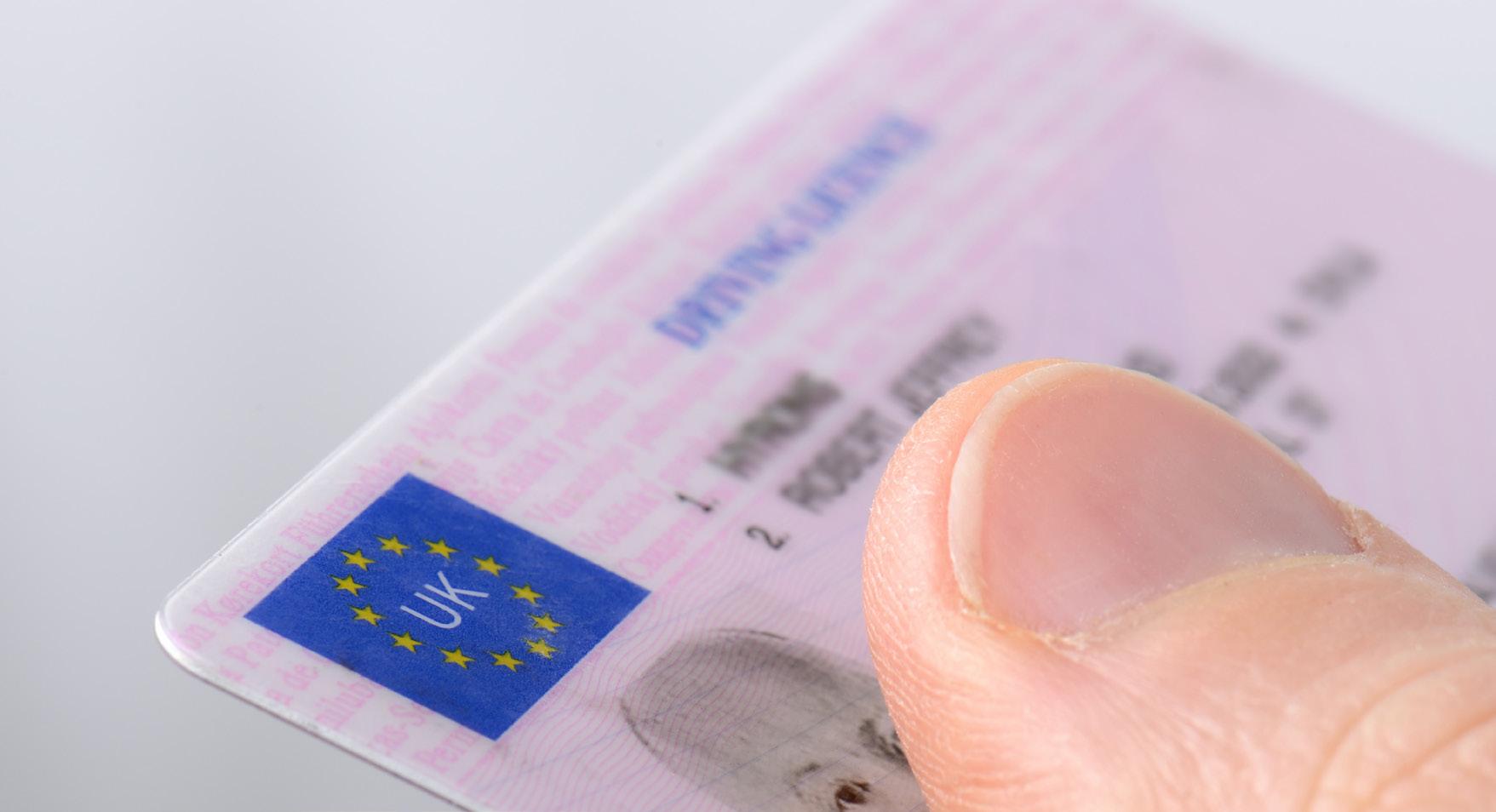
• Always keep your driving licence safe.
• Know your driving licence number.
• Know your licence renewal date.
• Keep the photograph on your licence up to date.
• Inform DVLA of any changes to your driving licence.

• Know what endorsements and penalty points are on your driving licence.

• Wherever possible, carry your driving licence when driving.
The driving licence is an official document that grants a driver the right to operate a vehicle. The Road Traffic Act 1988 states it is an offence for a person to drive a motor vehicle on a road without a licence authorising them to drive a motor vehicle of that class.
If a police officer asks a driver to produce their driving licence, they must do so however it is not a legal requirement for drivers to carry their driving licence while driving. Drivers will be given 7 days to produce their licence at a police station.
Driving licences are normally valid until 70 years of age unless restricted for medical reasons.

• Autumn can often bring new challenging driving conditions with temperatures dropping, nights drawing in and leaves falling creating slippery road surfaces.
• Driving can be difficult with the lack of clear visibility from low sun and fog. When driving in fog, set your headlights to low beam.
• Allow yourself plenty of room to stop in an emergency. Keep a greater distance from the car in front.
Reduce speed when driving on a road covered with leaves, especially when driving around corners.

Autumn brings increased rain fall. Check the condition of windscreen wipers and replace so they are effective in clearing the windscreen.
In wet weather it can take almost four times the distance to stop in an emergency. x4?
Check bulbs and lights every few weeks throughout the year, but especially as Autumn starts.
Falling leaves create road hazards. Wet leaves can be as slippery as ice. Fallen leaves can also hide road markings and obscure hazards like potholes and bumps.
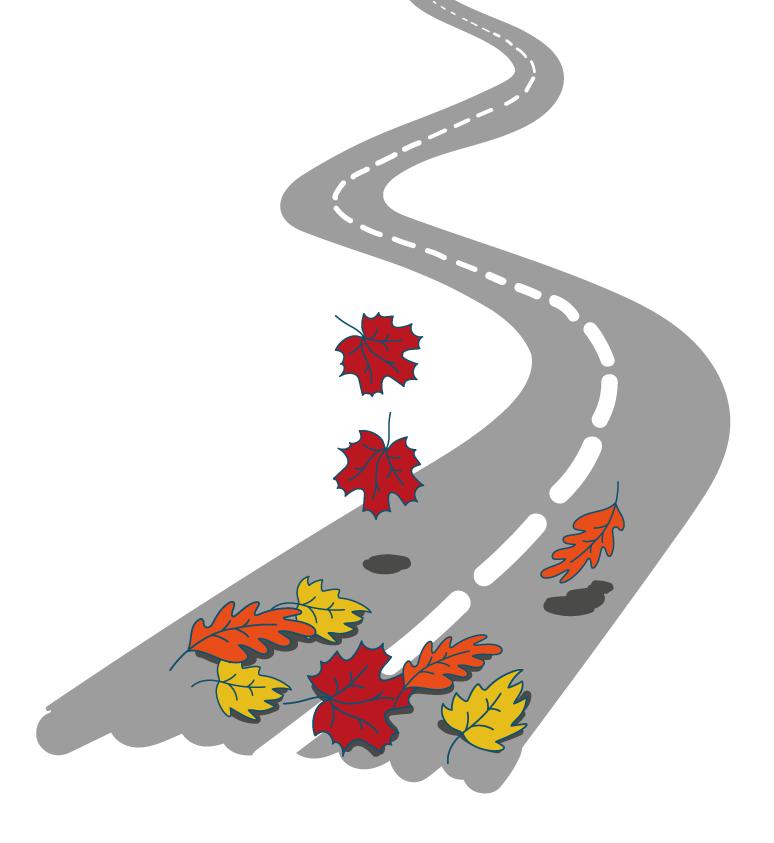
• Check all lights are kept clean.
• Glare when the sun’s low in the sky is more likely to be a problem at this time of year. Use the visor and wear sunglasses to minimise the sun’s glare.
• There will be more demand on your vehicle battery as temperatures cool. We suggest you replace the battery before waiting for it to fail.
• Early morning frost creates icy patches on shaded areas of the road and across bridges, so reduce speed.

• See and be seen – do not leave it too late to turn lights on.
• Check that tyres, brakes, wipers, heater and demisters are all in working order.
• Use the demister and windscreen wipers to clear your windows of frost or ice before setting out on a journey.
• Look out for animals crossing the road, especially deer.

• Our most recent data shows that, on average, 13%* of all fatalities and serious injuries on the Strategic Road Network include weather conditions as a contributing factor to the incident.
• Of these, 78%* occurred in the rain (four times more than any other adverse weather condition).

*Source STATS19 Road Safety Data www.data.gov.uk




Driving fast through water is dangerous, inconsiderate and can end up being very expensive. It only takes an egg cupful of water to be sucked into an engine to wreck it.
• Leave twice as much space from the vehicle in front.
• If steering feels light due to aquaplaning, ease off the accelerator and slow down gradually.
• Avoid driving into flood water that is moving or more than 10cm (4 inches) deep.
• Be mindful of throwing water onto pavements, soaking pedestrians or cyclists.
ng sts.



Strong winds can be a dangerous hazard when driving and can impact the ability to steer the vehicle and remain on a straight path of travel.
• Keep both hands on the steering wheel and your speed low.
• Prepare for strong winds and gusts on exposed stretches of road.
• Leave extra room around cyclists and motorcyclists as they may veer across the road.
• Maintain a safe distance from other vehicles, especially high-sided vehicles, and caravans.

• Remain alert to possible falling tree branches and other debris.
• Plan your journey carefully, checking weather and traffic bulletins regularly.
Fog is one of the most challenging conditions to drive in as it dramatically reduces visibility and makes the road ahead difficult to read.
Drivers who fail to exercise care when driving in fog can be held liable for injuries and other damages in a resulting vehicle collision.
• Maintain a greater distance from the vehicle in front, increase the gap to at least 4 seconds.
• Keep your windscreen clear and demisted.
• Use lights where visibility is reduced to 100 metres (328 feet) or roughly the length of a football pitch.
• Don’t rely on following the taillights of the vehicle in front, as these can give a false sense of security.
• If visibility is very limited, consider the necessity of your journey.
• One of the biggest hazards and challenges of Spring driving is low sun. You must ensure you can see where you are going.
• Use the vehicle’s sun visor and wear sunglasses to minimise glare.
• You must ensure your windscreen is kept clean and your washer and wipers are working properly.
Millions of drivers suffer from Spring allergies that cause runny noses, itchy eyes and sore throat. Many rely on medications that induce drowsiness which then places them at risk behind the wheel. Before combining any allergy medication with driving, read the instructions or consult with a pharmacist.
As temperatures start to rise, road speeds tend to also increase. Take care to watch speeds, especially in school zones or other areas where pedestrians or cyclists are present.
Spring hailstorms are common and even small hailstones can shatter windshields when traveling fast. Ice fragments left from hailstorms can also create hazardous driving conditions.

Slow down for Spring showers. The roads are the most slippery when it first begins to rain. This is caused by the rainwater mixing with contaminants on the road, such as oil and diesel. Increase the following distance (up to 4 times the normal required stopping distance) to allow for adequate braking.
Check tyre condition and inflation on a monthly basis. During the winter months, tyres lose air due to the cold temperatures, causing them to be underinflated. Less tread means reduced traction and increased fuel consumption.

Melted snow and ice melt can leave behind deep potholes in the road that can cause significant damage to vehicles and contribute to traffic accidents. Avoid swerving, instead, gently press on the brakes in a controlled manner to retain control of your vehicle.

Stay alert to the increasing amount of road users, especially motorcyclists and cyclists during springtime. Always check the surrounding area several times before manoeuvres such as changing lanes, turning, or reversing. When driving in residential areas pay attention to the surroundings and be prepared to brake and/or swerve out of the way of pedestrians, especially children and elderly people who may enter the road without warning.
Look out for animals crossing the road as they emerge out of hibernation.
• Hot weather can cause fatigue and irritability to drivers.
• Drivers can become easily dehydrated and it can affect their driving abilities.
• Drivers experience increased congestion from high levels of traffic on holiday routes and in road works for road construction and maintenance.

Summer brings out different road users. Look out for horses, tractors, caravans, horseboxes, cyclists and walkers.
Loose chippings are a common sight on roads in the Summer, they can cause cracked headlamps and windscreens, and damage paintwork. Stick to temporary speed limits as advised by road signage.
Construction increases during Summer. Driving by construction sites is frustrating. It causes traffic to slow down and that makes drivers more likely to rush to get where they are going when they finally get past construction zones.
People pay less attention driving during Summer as they are more relaxed and get easily distracted.
Keep a bottle of water in the vehicle, a 5% drop in hydration levels can cause a drop of up to 30% in concentration levels.

Keep windscreens clean as dirt and marks can amplify sun glare. Have access to and wear a clean pair of sunglasses while driving.

Stay alert. The number of people on the roads in the Summer increases. They may be unfamiliar with the roads they are travelling on causing confusion and therefore be more likely to make sudden turns or U-turns. They could also be more prone to crashing while distracted by trying to follow a map or satnav.

Drive extra carefully after rain, as it can turn dry surfaces into a skid area. Roads can be extra slippery when it rains after a long period of dry weather.
Keep the vehicle’s coolant topped up to reduce the chance of it overheating and turn the engine off when stuck in traffic as this too will prevent it from overheating.
Regularly check tyre pressures and condition on a monthly basis as the higher temperatures of Summer increase tyre pressure that could lead to the risk of tyre blowout.
In hot weather, vehicles may sometimes give unnecessary cause for concern. Here are are some examples:
• Pools of water under a vehicle which are caused by condensed water from the air conditioning system.
• Vapour from air vents is just water vapour produced by the air conditioning unit that has not had time to condense.
• Roaring from the engine bay is often the cooling fan turning on and off.
• If a vehicle seems to have less power, this is probably because the air is warmer and less dense, resulting in the engine being less efficient.
• Leaving the engine running while stationary, or ‘engine idling’ to defrost windows is an offence under Rule 123 of The Highway Code and authorities have the power to issue £20 fixed penalties for any contravention.
• Rule 229 of the Highway Code says: “Before you set off you MUST be able to see, so clear all snow and ice from all your windows.” If the windscreen is obstructed in any way, the police can fine drivers £60.

When driving in snow and ice:
• Make slow gentle manoeuvres to stay safe while driving in snow and ice as stopping distances are 10 times longer.


• When brakes are needed, they should be applied gently.
• Pull away in second gear, easing your foot off the clutch gently to avoid wheel-spin.
• Keep a constant speed and try to avoid having to change gear.
• If stuck in snow, straighten the steering and clear the snow from the wheels. Put a sack or old rug in front of the driving wheels to give the tyres some grip.
• Wear comfortable and dry footwear while driving.
Planning: Plan a journey carefully and listen to updates on weather and traffic news to help make it as smooth as possible.

Time: Allow more time than usual before leaving. Clear all windows and lights of snow and ice for visibility and your number plate. Clear snow from the roof, bonnet and rear of the vehicle as it can pose issues of safety to your driving and other road users.

Look: Look ahead to avoid any erratic steering and braking actions. Maintain speed and a safe distance and avoid tailgating at all costs.
Control: Always maintain full control to ensure vehicle stability while braking, accelerating, changing gear and applying steering angle as smoothly as possible.
Climate: Dress appropriately for the climate and take a hat, scarf and winter coat plus blankets and suitable provisions in case of a breakdown, getting stranded at the roadside or stuck in a lengthy traffic congestion.

Darkness: Driving in the dark can be tiring so take a break when necessary to stay safe.
Winter vehicle checklist:

• Check that the battery, ignition, lights, brakes, exhaust, wipers are all operational and fluid levels are all topped up.
• Check that tyres are all in good condition on a monthly basis making sure they have plenty of tread and have the correct tyre inflation to provide a safe grip.
• Check and replace windscreen wipers before they start to leave streaks or scratches on the screen when in use.
• Check the fuel level is sufficient for the journey and do not risk running out of fuel.
• Check all electrics including interior heating, wipers, and heated screens are working.
• Tailgating is one of the causes of road rage and police have powers to issue on the spot fixed penalties for inconsiderate lane use (including hogging the middle lane).
• Penalties range from a fine of £100 and 3 penalty points to a driving ban or prison sentence,depending on the seriousness of the offence.
• A driver should not use their horn in a built-up area between 11:30pm and 07:00am.
It is important that all road users are aware of any updates to The Highway Code, are considerate to other road users and understand their responsibility for the safety of others.
Eating, drinking and reading maps and guides should be carried out only when the vehicle is parked.

• Always be aware of your vehicle’s road position.
• Always keep left unless overtaking.
• Provide clear signals in plenty of time to inform other road users, including pedestrians of any intended actions and cancel them after use.
• Pull into a safe place to let other drivers pass if queues build up behind you.
• Drive courteously and safely around pedestrians, horse riders and cyclists.
• Be extra-cautious, especially when visibility is restricted by hedges, bushes, walls and in poor weather conditions.
• Never assume that flashing headlights is a signal inviting you to proceed. Do not flash your headlights to intimidate other road users.
Maintaining a safe distance between your vehicle and the one in front is essential to ensure adequate reaction and braking time should they suddenly stop.


Remember the 2 second rule, to ensure you have adequate space between you and the vehicle in front “Only a fool breaks the 2 second rule”. If it is wet, visibility is less, or when towing a trailer, increase the time to 4 seconds.
When being followed by an emergency services vehicle, a driver must pull over and let them pass. When being followed by a police officer who wants you to stop, they will indicate this by flashing their lights and signalling with their left indicator. Drivers must find a safe place to pull over as soon as safe and legal to do so.

• There are 7 main government bodies responsible for road safety.
• It is an offence not to stop when asked to do so by the Police and drivers face an unlimited fine, community order or up to 6 months’ imprisonment and 3 – 9 penalty points or disqualification from driving.

• DVSA officers wear yellow visibility jackets with either the VOSA or DVSA logo and always carry a DVSA warrant card.
The police and DVSA have the power to carry out spot checks on vehicles and issue prohibitions if necessary. When stopping vehicles, DVSA use marked cars. They can stop any vehicle on the road.
Drivers should be wary of bogus DVSA officers trying to stop vehicles on highways.
Under a new agreement, DVSA and National Highways now work together to pull in lorries, vans, buses, and coaches on West Midlands motorways while sharing Automatic Number Plate Recognition (ANPR) data and other intelligence in real time. This will help to improve road safety.
The Home Office is responsible for setting priorities for police forces, reviewing charges and penalties for traffic offences, and for victims’ rights.

The Department for Transport is responsible for road safety policy in many areas of road safety, from producing guidance for local authorities (e.g. speed limits), to reviewing road safety legislation (e.g. banning handheld mobile phones, or the drink-drive limit). It commissions research on road safety topics and runs national publicity campaigns.
National Highways is the executive agency responsible for operating, maintaining, and improving all motorways and major trunk roads in England. National Highways Traffic Officers are there to support road users and keep them safe. They cannot enforce traffic law but, when prompted, road users must comply with their instructions regarding safety.
The Driver and Vehicle Standards Agency (DVSA) is responsible for annual testing of vehicles and enforcement checks on the maintenance standards of lorries, buses and coaches, and their compliance with laws including drivers’ hours rules. It is also responsible for driving tests and promoting road use rules such as the Highway Code.
The Driver and Vehicle Licensing Agency (DVLA) is an executive agency promoting road safety and general law enforcement by maintaining registers of drivers and vehicles, and it collects vehicle excise duty (tax).
Local authorities are responsible for local roads that are not motorways or major trunk roads.
Traffic Commissioners are regionally appointed officials with responsibility for licensing companies to operate lorries, buses, and coaches. Traffic commissioners have powers to issue and take away an operator’s licence.
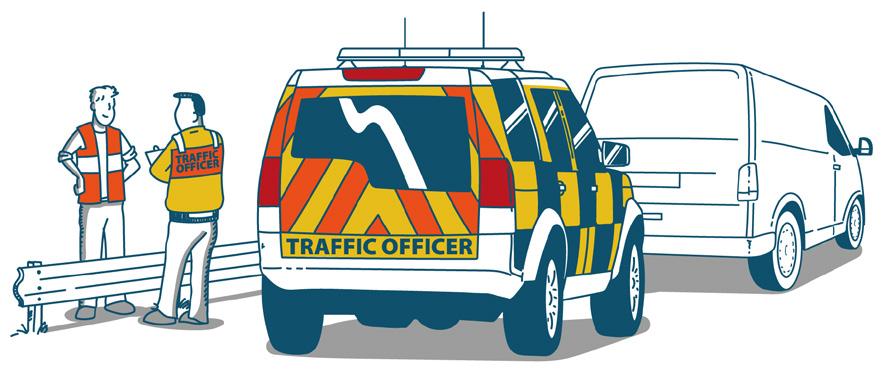
• Weight, driving style and maintenance all affect a van’s fuel economy.
• An unnecessary 45kg in the vehicle reduces mpg by 1%.
• Engine idling can have a significant impact on vehicle’s fuel economy.
• Excessive speed is the biggest fuel-guzzling factor.
The heavier a van, the more fuel it requires to move so consider whether everything being carried is essential.
Regular maintenance and servicing will improve the efficiency of a vehicle and improve fuel consumption.
One of the keys to saving fuel is avoiding unnecessary changes in speed when driving.

Equipment such as ladders carried on the vehicle’s roof creates drag which increases fuel consumption.

• Look ahead and anticipate oncoming hazards.
• Keep moving and do not lose momentum if safe to do so.
• Ease off the throttle to reduce speed instead of using the brakes.
• Keep windows closed.
• Listen to the engine to avoid using excessive revs.
• Lighten the load by not keeping unnecessary items in the vehicle.
• Where possible, make one round trip rather than several short trips.
Aggressive driving (speeding, rapid acceleration, and braking) wastes fuel. It can lower fuel economy by 15% to 30% at highway speeds and 10% to 40% in stop-and-go traffic.

A warm engine will operate at its most efficient whereas several cold starts will increase fuel consumption.
Incorrect tyre pressures adversely affect fuel economy. Tyre pressures will vary depending on the load being carried.
The biggest secret to achieving high mpg is driving in the highest possible gear for the vehicle while keeping within the speed limit.
Drivers should anticipate what is going to happen in front by looking well ahead. Seeing traffic lights on red means a driver can ease back on the accelerator or slow down naturally and potentially keep moving as opposed to coming to a stop.
Air conditioning uses engine power and increases fuel consumption.
• The speed limit on a motorway is 70 mph (where national speed limit applies). Large vehicles and vehicles towing trailers have a speed limit of 60mph unless other limits are shown.
• If caught speeding on a motorway, a driver could be fined up to £2,500.
• Unless directed to do so by a Police or Traffic Officer, drivers must not reverse along any part of a motorway. If you have missed your exit, or have taken the wrong route, carry on to the next exit.
When there are three or more lanes, certain kinds of vehicles can never use the right-hand lane, these are:
• Vehicles with trailers,
• Speed-limited goods vehicles between 3.5 and 7.5 tonnes,
• Any vehicle over 7.5 tonnes,
• Speed-limited vehicles meant to carry more than 8 passengers.
In the event of a fallen item or other obstruction on a motorway, drivers should stop in a place of relative safety and contact the emergency services to report the incident and request help. They must not attempt to retrieve items that fall from a vehicle or attempt to move an obstruction.

Do you know the different features on a motorway? Motorways have reflective coloured studs which are designed to guide drivers when driving at night:
Red – hard shoulder
Amber – central reservation
White – mid-lane
Green – slip road
In addition to the standard motorway with a hard shoulder, there are three other types of motorways that you may drive on:
• Dynamic hard shoulder: the hard shoulder is temporarily open.
• All lane running: the full width of the road is usable with emergency areas.
• Controlled motorway: with 3 or more lanes, a hard shoulder and variable speed limits.



Red X – a red X sign is used to inform drivers of a closed lane to traffic. When displayed, drivers must not use that lane. Driving under a red X sign is illegal and could result in an automatic £100 fine and 3 penalty points.
Hard Shoulder – on some motorways the hard shoulder can be used as an extra lane to help create more capacity on the motorway. Overhead signs will inform drivers when the hard shoulder is available for use and a variable speed limit will be in force to help manage traffic flow.
Variable Speed Limits –variable speed limits allow National Highways to adjust the speed limit on a motorway during busy periods. The current speed limit is displayed on overhead signs.
Driver Information Signs –
National Highways use the overhead driver information signs to warn drivers about queuing traffic ahead and any speed limits in force so that they can take preventative action by slowing down.
• More than four million journeys are made on the strategic road network each day. On average, National Highways record around 196,000 breakdowns per year (536 each day).
• The most common breakdowns are related to tyres, overheating, electrical problems and running out of fuel.
If your vehicle develops a problem or if you break down on the motorway:
1. Put your LEFT indicators on.
2. Move into the LEFT lane.
3. Exit LEFT at the next junction/services, or
4. Exit left into an emergency area or hardshoulder.
5. Put your hazard lights on.
6. Get behind a safety barrier and keep well away from moving traffic.


7. Call National Highways on 0300 123 5000 then a breakdown provider for help.
If you cannot do the above, or in an emergency, stay in your vehicle, keep seat belts and hazard lights on. Call 999 immediately.
Emergency SOS phones are usually situated at one-mile intervals along the hard shoulder of a motorway. Emergency areas are designed to offer places to stop in an emergency or breakdown for vehicles on roads without hard shoulders.

Do not exit an emergency area without speaking to National Highways first. They will close the lane to help you re-join the motorway safely.

For more advice visit: https://nationalhighways.co.uk/road-safety/breakdowns/
It is recommended that drivers take with them a charged mobile telephone, containing emergency numbers, and high-visibility clothing in case of emergency or breakdown.
Most breakdowns are avoidable and simple vehicle checks can help you have a safer journey.

• Tyre tread – check the legal minimum tread depth for your vehicle as it can affect your grip, braking distance and steering
• Tyre pressure – check your tyre pressure as under-inflated or over-inflated tyres can affect your braking distance, steering, fuel efficiency and the lifetime of your tyres
• Lights – check lights are working as they are not only essential for you, they are also essential for other drivers to understand how you intend to manoeuvre
• Fuel – check you have sufficient fuel for your journey
• Oil – maintaining the correct oil level is essential as the oil lubricates, cleans, cools and protects the moving parts of your engine, preventing your engine from seizing up and breaking down
• Screen wash – to ensure you have good visibility, always keep your screen wash topped up so you can clear any debris off your windscreen.
• In 2019, there were 60 fatalities involving vans and vulnerable road users.
• 62% of cyclists killed or seriously injured were involved in collisions at, or near, a road junction.

• Post collision, drivers could face financial claims from a vulnerable road user covering their loss of wages, medical expenses and any recovery treatment.
When overtaking motorcyclists, cyclists, horse riders, horse drawn vehicles and pedestrians in the road, allow them at least as much room as you would when overtaking a car.
Drivers should check blind spots frequently and whenever turning left or going round roundabouts to watch for other road users.
At a junction, drivers should give way to pedestrians crossing or waiting to cross a road into which or from which the driver is turning, and never cut across cyclists, horse riders or horse drawn vehicles going ahead when they are turning into or out of a junction.
Drivers should ensure their mirrors are accurately set to maximise their visibility.
• Be patient and give others time and room.
• Watch your speed.
• Expect to encounter different road users i.e. horse riders in rural locations.
• Be ready for others to make mistakes.
• Do not get distracted by using a mobile phone while driving.
• Concentrate on your driving.
Drivers should always be mindful of other road users, especially those who are vulnerable due to a lack of protection. Vulnerable road users include:
Pedestrians – especially children can walk into the road with little warning. Over 30 child pedestrians are killed or seriously injured each week. Drive with extra care in shopping and in residential areas.
Cyclists – Drivers should give way to any cyclists in a cycle lane, and not cut across them when turning or changing lanes. Always be prepared to stop and wait for a safe gap in a flow of cyclists before crossing the cycle lane.

Motorcyclists and moped riders – are more difficult to spot at night where their light is obscured by other vehicles’ lights. Be extra cautious when moving out of a junction.
Disabled, elderly and inexperienced drivers – make allowances for older drivers and disabled drivers as their reactions may be slower, or they may simply need more time than other drivers.

Animals – do not scare animals by sounding the horn, revving the engine, or accelerating rapidly after passing them.

• The EU Parliament Road Safety Group reports that 86% of all rollover accidents involve driver error.
• The centre of gravity (CoG) for delivery vehicles will move due to the changing load.
• The higher the centre of gravity, the easier it is to overturn the vehicle.
• A slope of more than around 33% will usually cause a vehicle to rollover.
The main driver errors which result in vehicle rollovers are failing to control the motion of the vehicle, speeding, lack of attention and driver distraction.
As a vehicle empties during the route and the centre of gravity moves, the load may need to be adjusted to improve load stability and stop load movement.

The weight of the vehicle is directly proportional to the braking time and so vehicles react differently with different loads. When fully loaded, vehicle braking becomes more difficult, stopping distance and time increases and turns and curves require more attention by the driver.
Do not assume that the road ahead is safe, or conditions are unchanged if you have travelled it previously.
The load in the van must be secure. Movement of the load can affect the centre of gravity of the vehicle, causing it to be unstable to drive and with the potential to rollover.


• Eliminate distractions and always pay attention to the road and how the vehicle is handling.
• Scan the road ahead looking for hazards and changing conditions.
• Sound your horn when you approach tight rural road bends and anticipate oncoming traffic.
• Avoid sudden manoeuvres, oversteering, over-acceleration, and harsh braking.
• To maintain full control and stability of the vehicle and load, reduce speed in rain, fog, snow, or icy conditions, and if the road has a lot of mud, gravel, or debris along its surface.
How a vehicle is loaded can significantly affect its handling on the road and the likelihood of the load moving or becoming unstable during the journey.
The centre of gravity of a loaded goods vehicle tends to be much higher than that of a passenger car. This makes a goods vehicle more likely to rollover than a car at the same speed.
The road design can influence vehicle rollovers as the risk increases when roads bend sharply, or when roads have adverse cambers or ditches running alongside the road.
Multi-drop deliveries can cause drivers issues with their responsibility for the safety and security of the load.
Drivers must take an adequate amount of time necessary to use appropriate equipment to secure the load properly. Loads should be distributed between axles and the weight spread as evenly as possible, fully utilising the vehicle’s floor area.
Drivers should be wary about axle overloads and moving centres of gravity when removing large portions of the load from either the front or the rear of the vehicle loading area.

• A driver can be fined up to £300 or get a court summons if their van exceeds its maximum permitted axle weight.

• Exceeding the manufacturer’s load limit can put serious strain on the vehicle and may invalidate insurance cover.
• Overloaded vans are a common issue in the UK, 89% of vans stopped by DVSA are overloaded.



Remember it’s easy to overload the front axle of a van by removing load from behind the back axle. Think of it like a seesaw! It is the responsibility of a van driver to stay within the weight limits.
When loading a van, it is not the size of the boxes/load or how full the van is that matters – it is the weight of the boxes/load and where they are placed that is important.
A driver should not exceed their van’s legal maximum loaded weight.
If the vehicle is overloaded to the point where it is a hazard to other road users, the driver can be charged with dangerous driving and the offence may carry a prison sentence.
• Drivers should know their van’s axle weights as it is extremely important that any load is distributed correctly across both axles.
• Each axle has a weight limit. If the vehicle exceeds either front or rear axle weights, it is breaking the law.
• Drivers should regularly get their van weighed at a local weighbridge.
A van has a ‘gross vehicle weight (GVW)’ or ‘maximum authorised mass’ (MAM) which can be found on the VIN plate. This is the maximum weight that a van is legally allowed to weigh when loaded. It includes: the van, the fuel, the driver and any passengers and any load being carried. It will be listed in the owner’s manual and is normally shown on a manufacturer’s plate or sticker fitted to the vehicle. The position of the plate does vary but the most common location is inside the front door panel.
When a van is empty but fuelled, its weight is called the ‘unladen weight’ or the ‘kerb weight’.
The ‘payload’ is any load carried by a vehicle. It is the total weight of what a driver can safely load into the van and includes all passengers, luggage, tools, etc.

A van’s performance and safety will be affected when a driver overloads it or its individual axles.
To calculate a payload while staying within the legal GVW limit, drivers can do a simple calculation by subtracting the van’s unladen weight from the van’s gross vehicle weight (GVW). An example of this would be;
GVW of 3500kg minus the unladen weight of 2210kg = a payload of 1290kg.
• Each year, DVSA issue over 2,000 prohibitions to drivers of vehicles which present a road safety risk because of poor load security.
• Where a vehicle’s load is deemed to be in a dangerous condition, the driver can receive 3 penalty points and a licence endorsement.
• Drivers and their employers can be fined up to £5,000 per overloading offence.

The driver is responsible for the vehicle and any load while driving on the road, regardless of who loaded it.
Overloading changes the way a van handles – especially if the load is unsecure and will increase fuel consumption.
The driver is required to ensure the load is secured to the vehicle so it cannot cause a danger to anyone.
Consequences of poor load securing can result in death or serious injury, damaged reputation and prosecution.





• The load should be placed against the bulkhead to prevent the load sliding forward.


• Heavy items should be stacked at the bottom and lighter items at the top.
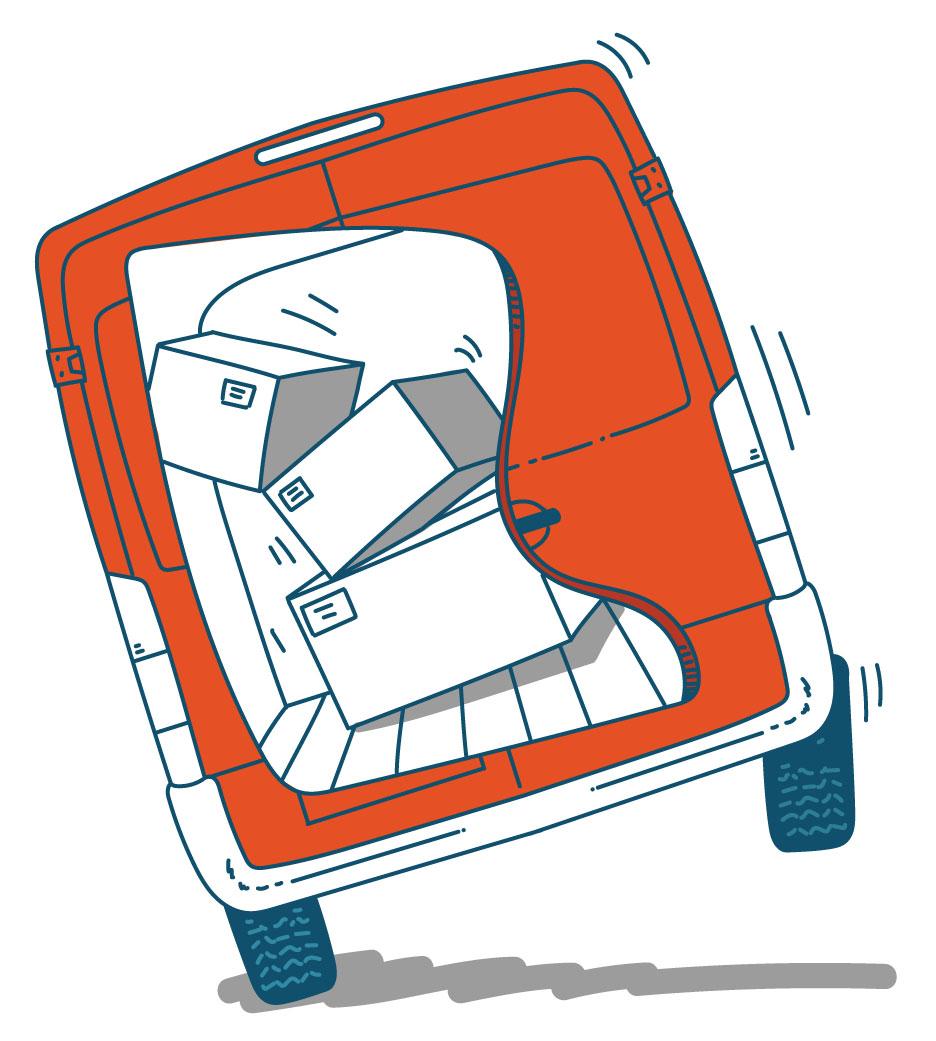
• All load restraints in use should be in good condition and appropriate for the load.
• If any part of the load moves while driving, the driver should pull in a safe place to re-secure it.
• The load should be loaded so its weight is distributed evenly across the vehicle.

• The load should be stable and secured to prevent it sliding forwards and backwards or toppling over.
The loading, securing of goods on vehicles, and their unloading, falls under two areas of law in the UK:

• The Road Traffic Act 1988 and workplace safety legislation;
• The Health and Safety at Work Act 1974.
Incidents happen when drivers and employers underestimate how much restraint is needed to keep a load on a vehicle. Load securing systems in use should be appropriate for both the loads being carried and the vehicles being used.
Drivers should be mindful of their driving habits to ensure safety. The main reasons for a load moving include roundabouts, slip roads, long (fast) corners, under braking and swerving to avoid obstacles.
• Drivers face a non-endorsable fixed penalty of £50–£100 for causing an unnecessary obstruction by parking opposite or within 10 metres (32 feet) of a junction.
• The average motorist in the UK spends nearly 4 days every year looking for parking spaces.
• Parking lights must be used during the night on a road or layby on a highway with a speed limit higher than 30mph.
A single yellow line – either painted on the road or on the kerb – means no waiting, parking, loading, or unloading at the times shown on the accompanying sign.
A double yellow line – either painted on the road or on the kerb –means parking and waiting are not permitted at any time.

Loading bays and parking spaces should not be confused. A loading bay will be marked by a dotted white line surrounding it, along with the words ‘Loading Only’ painted on the road.
Drivers could get penalty points on their licence for leaving a vehicle in a dangerous position.
• Do not park facing against the traffic flow.
• Do not park too close to a vehicle displaying a Blue Badge.
• Switch engine, headlights, and fog lights off.
• Rule 248 of the Highway Code states: “You must not park on a road at night facing against the direction of the traffic flow unless in a recognised parking space.”

• Drivers must not drive or park in a cycle lane marked by a solid white line during its times of operation, or drive or park in a cycle lane marked by a broken white line unless it is unavoidable.
When exiting the vehicle, drivers must ensure they do not hit anyone when opening their door and should check for cyclists or other traffic by using mirrors and looking all around them.
In some cases, single red lines are used instead of yellow lines. The times that the red line restrictions apply will be shown on nearby signs, but a double red line means no stopping at any time.
Drivers risk a fine and penalty points by parking on yellow or white zigzag lines. Yellow zig-zags needs an accompanying sign to be legally enforceable. White lines, on the other hand, are enforced by local authorities and the police and they do not require a sign to be enforceable.
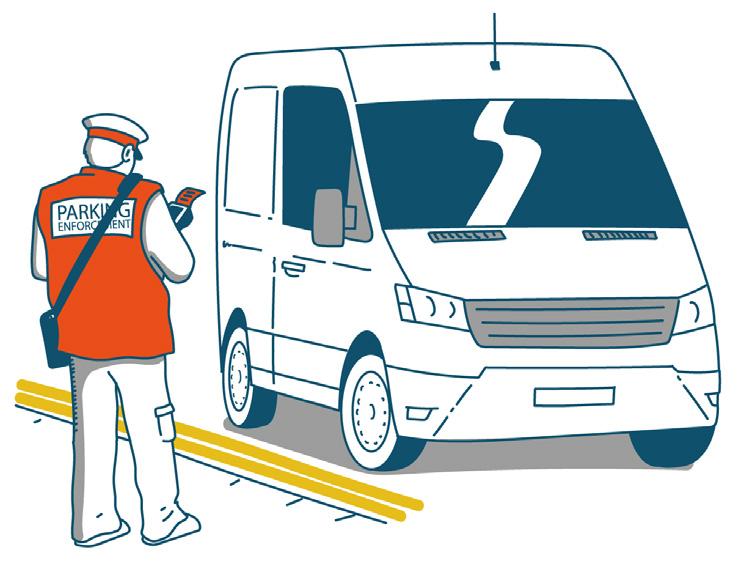
A red cross over a blue background indicates a clearway, which means no stopping at any time – not even to pick up or set down passengers.
Avoid parking on the pavement as it causes an obstruction and is antisocial for pedestrians. Parking on the pavement is illegal in London. Driving on the pavement is an offence.
• Thousands of road incidents occur due to debris and other objects flying off from vehicles.
• It is an offence and drivers face prosecution when using a vehicle or trailer on a road if it involves a danger of injury to any person.
• Drivers face fines up to £2,500 and 3 penalty points if any part of the load is unsafe/insecure or the vehicle is overweight.
Always use a suitable vehicle when transporting loads and equipment.
Ladders and equipment carried on the exterior of a vehicle must be adequately secured to avoid incidents when driving.
When driving on the road, listen out for rattling as this may suggest that the ladder and equipment are not secured tightly enough. Pull over into a safe area to check the security of the equipment and adjust as needed.
Do not take risks when transporting equipment on the exterior of a vehicle, as it can be illegal and dangerous.

• Check any ladders or equipment are fully folded up and any locking mechanisms are properly engaged before driving.

• Ladders should be secured at both the front and back using ladder clamps, padlocks, bungee cords, ropes, or other strong ties.
• It is important to know and stay within the maximum
limits on both the front and back of a vehicle.
• Take a short test drive in a safe area with the ladder and equipment in place on the vehicle, turning sharp corners and braking abruptly to ensure they are securely in place.
• Ensure there are no loose items – everything should be fixed, strapped down or covered.

Exceeding 3.05m 2 clear working days’ notice to Police Attendant and marker boards are required
2 clear working days’ notice to Police
Attendant and marker boards are required
Towing with a van could:
• Mean you need different driving licence categories.
• Require use of EU drivers’ hours rules and tachographs (although there may be exemptions you can use).
• Overload the towing vehicle beyond its legal and / or physical capabilities.
Vans with a Gross Vehicle Weight (GVW) of up to 3500kg can tow trailers up to 7 metres long and 2.55 metres wide.

Trailers with a GVW of 751kg or more are required to be fitted with independent brakes.




No part of the load in the trailer should overhang by more than 3.05 metres, not exceeding a width of 2.9 metres and it all must be secure.
Any trailer used must be subject to the same pre-use checks as the towing vehicle.
Trailers and couplings can differ, so always follow the manufacturer’s instructions.
Make sure you know how to hitch the trailer correctly and connect the emergency brake cable.

• Evenly distribute the weight of the load in the trailer.
• Make sure any load in your trailer is properly secured.
• The trailer being towed must display the same number plate as the van.
• Ensure the nose weight of the trailer is within the manufacturers recommendations of the towing vehicle.
• If the trailer starts to swerve, slow down gently.
• There is a towing speed limit of 60mph on motorways and 50mph on single carriageway roads.

• If the trailer is wider than the van, then towing mirrors will need to be fitted.

The chassis plate or sticker fixed by the manufacturer specifying the maximum weights allowed is often found on a front door sill. The weight and size of trailer that you can tow depends on at least 5 key factors:

• Driving licence categories.
• The capability of the towing trailer.
• The weight capacity of the trailer.
• The brakes on the trailer.
• Gross weight of towing vehicle and size of trailer.
• The use of vehicles as a weapon to injure and kill people has become a real threat. This is referred to as a ‘vehicle as a weapon (VAW) attack’.

• Vans pose an increased risk if used in VAW attacks because of their size, profile and weight.

• Crowded public spaces are targeted for VAW attacks.
In an emergency drivers should call 999. To report suspicious behaviour drivers should call National Counter Terrorism Security Office on 0800 789 321



Drivers should always comply with their organisation’s positive security behaviours.


The use of social media to publicise delivery and parking locations is not advisable.
Vehicles not in use must have all their doors and windows locked and the ignition keys to be taken with the driver.
• Be aware of what is happening around you and your vehicle.
• Be mindful of being followed by anyone behaving suspiciously.
• Where possible, always park in a secure, well-lit location.
• When leaving or returning to a vehicle, look for signs that something has been concealed or the vehicle tampered with.
• Do not leave vehicles unattended with engines running.
• Always take ignition keys away when leaving the vehicle.
• Drive to a police or fire station if you believe you are being followed and cannot safely call the emergency services.
• Do not attempt to fight aggressors or defend the vehicle. Remove yourself to a safe location and call emergency services.
Drivers should always think Security as well as Safety by:

• Avoiding talking about loads or routes with unauthorised persons. • Locking and securing the vehicle and keeping the keys safe. • Never carrying goods for anyone, other than the authorised load. • Informing their Manager immediately if being forced to change their route.

• Not allowing unauthorised passengers into the vehicle.
• Keeping ID documentation and wallets secure and out of sight.
• Being aware of attempts to deceive, such as by bogus Police and DVSA Officers.
• For road traffic collisions, details should be exchanged with all parties involved.
• If details are not exchanged, this should be done as soon as reasonably practicable, within 24 hours or reported to the Police.
• Drivers face a fine up to £5,000 and up to 10 penalty points on their licence, a potential driving ban and a prison sentence of up to 6 months for failing to stop or report an accident or collision.
It is an offence under Section 170 Road Traffic Act 1988 to fail to stop at the scene of an accident.
Drivers must report any workrelated road collision, incident or near miss in which they are involved, or witness and co-operate with their organisation’s reporting and investigation procedures.
Drivers involved in a collision resulting in damage or injury, must provide the required information to anyone with ‘reasonable grounds for requiring it’.

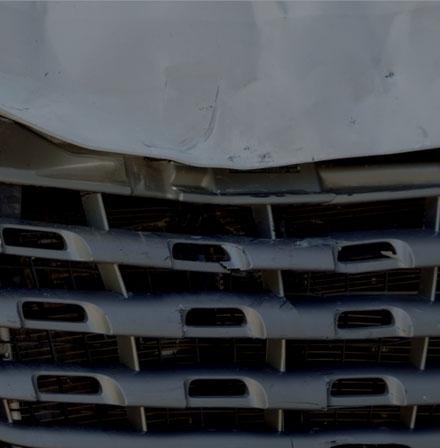


Whenever possible drivers should sketch or take a photograph of their collision/incident scene.

Vehicle collisions involving the following animals must be reported to the Police, whether the animal was killed or not: Dogs Horses Cows Pigs Sheep Goats Donkeys Mules

Information for drivers to provide when involved in a collision:

• their name and address.
• the vehicle registration number.
• the owner’s name and address if the driver of the vehicle does not own it.
Essential information for drivers to gather at the scene of a collision/incident:
• Date, time, and exact location (with reference to a fixed point).
• Environmental conditions (visibility, road surface, condition, etc).
• Registration number, model, colour, position, and direction of travel of all vehicles and other parties.
• A brief account of what happened.
• Photos of any damage to all vehicles involved.

• Other driver’s name and address and contact details.
• Other party’s insurance company details.
•Damage to all vehicle(s) and/or property.
• Number of passengers in the vehicles.
• Injury to driver and/or passenger and other parties.
• Names and addresses of any witnesses.
• Any other relevant factors such as personal health, stress, fatigue, etc.
• Consider using a dashcam and other incident reporting tools and apps.

• 80% of transport-related incidents occur when the driver is loading and unloading.
• Falls from vehicles represent 33% of workplace transport incidents.
• The most common area of the vehicle for people to fall from is the load area, followed by the vehicle’s cab access steps.
Before leaving the vehicle, visually check the ground for obstructions and identify a clean and level area to place feet onto.

The correct use of grab handles and handholds play a vital role in avoiding falls to and from a vehicle or use of the steps.
Always use three points of contact when climbing up or down from vehicles.
Use steps provided as jumping off a vehicle results in slips and falls and causes strain on a driver’s back and knees.

• Climb into the vehicle forwards and exit the vehicle backwards.
• Always wear appropriate, non-slip footwear and personal protective equipment, if provided.
• Keep steps and footwear dry and clean.
• Keep the vehicle bed tidy of debris and spillages to prevent slips and trips.
• When moving any part of the load, beware of falling stacked materials and objects.

• When closing doors and shutters, keep fingers and hands away from the closure area.
Take adequate time to access and exit the vehicle, as most injuries are caused by drivers rushing.
Before climbing up or down from a vehicle, ensure it is secure and stable with a brake applied and parked on level, well-lit ground.
Handholds and handrails provide a grip for the hands, that form part of an overall support system for accessing and exiting the cab of the vehicle. Handrails have the advantage that the hand can be slid along it without having to release grip completely.
Know your limits and test the weight of the object before attempting to lift the object and exiting the vehicle with it. Break down heavy or awkward items into a smaller manageable size and weight. Don’t carry items in your free hand when exiting the vehicle. Instead, place them on the vehicle floor and retrieve them once you are on the ground.

• Drivers face fines up to £2,500, a ban from driving and 3 penalty points for driving a vehicle in a dangerous condition.
• Wearing a seat belt is law and can result in fines of up to £500 if not wearing a seat belt when supposed to.
• Airbags reduce fatalities by 24% in head-on collisions.

• 1 in 4 deaths involving vehicles driving for work.
Drivers should take the time to read the vehicle manual and familiarise themselves with any safety aids.

The function of a bulkhead is to keep the driver and passenger safe.
Bulkheads keep all work equipment, tools and packages for delivery caged and secure in the rear of the van.
50% of drivers do not understand their vehicle’s safety features.
They prevent unsecured items in the back of the van from flying forward injuring occupants in the event of heavy braking.
People thrown from a vehicle are 4 times more likely to be killed than those who were wearing a seat belt and remain inside the vehicle.
Airbags are essential when it comes to vehicle safety. Along with seat belts, they help prevent potentially fatal injuries.

Reversing and parking aids minimise the chances of damage, injury, or prosecution. They can detect obstructions around the vehicle in the driver’s blind spot such as bollards, pedestrians and other vehicles.
The European Parliament has voted to implement 7 new minimum commercial vehicle safety standards from 2022:
1 Intelligent Speed Assistance – uses GPS to work out the speed limit of the road being travelled on. If driven faster than the limit, the vehicle will automatically slow down.

2 Reversing detection and reversing camera – to reduce rear collisions.
3 Drowsiness and distraction monitors - detects a driver’s physical movements like slow eyelid closure, the rate of blinks, and a nodding head.
4 Autonomous Emergency Braking (AEB) – automatically applies the brakes to avoid a collision.

5 Lane keeping assistance – detects lane deviation.
6 Event data recorders – a ‘black box’ that records vehicle events.
7 Improved seat belts – provides reminders for driver and passengers.
• Theft of vans has been increasing over the last 5 years. Over 8,000 vans are stolen each year.
• Thefts from vans is also a massive problem with over 28,000 thefts per year.
• Most thefts from a van occur where the driver parks at home.
• Thefts of contents are often opportunistic and may occur kerbside when the vehicle is being used.
Theft of content from vans, often tools and packages for delivery, frequently cause significant damage to the vehicle and make it undriveable.
Criminals have developed sophisticated techniques aimed at bypassing vehicle anti-theft devices such as ‘jammers’ to intercept the signal between a key fob and the vehicle, leaving the vehicle unlocked and vulnerable to theft.

Make sure the indicator lights flash back at you to show the vehicle got your signal and locked, and that it wasn’t jammed.
To stop the keys signal being relayed put them in a faraday pouch (signal blocker).
Thieves will be less likely to target a vehicle if they believe they might be disturbed.

• Always park in a place that is well-lit and open to public view. Use car parks that are security patrolled or covered by CCTV.
• Clear away any evidence of tools, equipment, packages for delivery and personal belongings from view when leaving the vehicle.
• Stereos and sat-nav should not be left on view when the driver is not in the vehicle.
• Letters, bank statements or forms of identification should not be left in a vehicle.
• Alloy wheels can be a target for thieves, so protect them with locking wheel nuts.
Vehicles in the UK fitted with keyless entry and ignition systems (which allow the vehicle to be opened and started without taking the key from a pocket), are susceptible to being driven away in seconds.



Adding visual deterrents to the vehicle is a good way to avoid theft. The use of steering locks and a pedal box, blocking access to all the vehicle’s pedal controls, and having additional visible locks on vans will put thieves off attempting to drive off with the vehicle.

Vehicle keys should never be left unattended in public and when at home, keys should be kept out of sight and out of reach.
Even when in slow-moving traffic or stuck in a jam, a vehicle is at risk of theft. Windows should be closed, all doors locked and valuables kept out of sight.
Always make sure you’ve locked all doors and closed windows when leaving your van only for a short time.
Tradesmen and delivery drivers are often targets for opportunist thefts of vans and their contents.
• Mobile devices are a major distraction but they are not the only one.
• Distractions can include eating, drinking, setting satnav, radios etc - anything that takes your eyes off the road or distracts your concentration on driving.
• Distraction is a major cause of collisions with drivers 4 times more likely to be in a crash if using a mobile device (even hands free).
40% of drivers name hand-held mobile phone use as one of their top 4 road safety concerns.

Drivers must not text, make calls, play games, scroll through playlists, take photos or videos, or browse the web while driving. An offence is triggered whenever a driver holds and uses a device, regardless of why they are holding it.
It is illegal to hold and use a phone, sat nav, tablet, or any device that can send or receive data while driving. If caught doing so, drivers can face fines of up to £1,000, receive 6 points on their licence, or a full driving ban.
Many employers will also discipline drivers for doing so and it will increase the cost of vehicle insurance.
Just reading a text or email takes a driver’s eyes off the road for at least 5 seconds.
• If using hands-free devices, make sure they are fully set up before starting to drive.


• Only use hands-free devices when you are happy it is safe to do so.
• Always ensure a clear view of the windscreen and road ahead.
• Do not hold or interact with a mobile device while driving.
• Where possible, switch mobile phones to a form of safe-driving mode e.g. silent mode or switched off.
• Using a mobile phone for navigation is legal, as long as it is kept in a cradle and not in the driver’s hand.
The government is considering increasing the penalty of causing death whilst driving when using a hand-held device from 14 years to life imprisonment.
Although the law allows drivers to use their phone while driving, if it is properly set up as a hands-free device, your employer’s policy may not allow this.

Hands-free devices attached to the windscreen or dashboard should not obscure the driver’s view of the road. Drivers can get 3 penalty points if they do not have a full view of the road and traffic ahead or proper control of the vehicle.
Distracted drivers who cause death or serious injury by dangerous driving face a maximum penalty of 2 years imprisonment, unlimited fine and obligatory driving ban.
• 90% of road collisions are caused by, or involve, human error.
• Drivers face fines up to £5,000 and up to 9 penalty points for careless and inconsiderate driving if their vehicle causes an obstruction when it has run out of fuel.
• There are around 3 to 6 major bridge strikes every day due to drivers not knowing their vehicle height.
Driving is the most dangerous work activity that the majority of people do.
Before operating any vehicle, drivers should receive appropriate vehicle familiarisation training and drivers should not be authorised to operate any vehicle they have not received training on.

Training must be provided to ensure drivers are competent to carry out their tasks and duties.
Drivers should be trained to report all work-related safety concerns, road incidents and near misses to their manager.

Well-trained drivers make the roads safer for all users.
Drivers have a responsibility to attend training when offered and familiarise themselves with company policies and procedures to ensure the safety of themselves as well as other road users.

Driver training helps eliminate bad driving behaviours.
Well-trained drivers strive hard to avoid incidents and collisions on the roads.
Regular driver training can make vehicular incidents less likely to happen.
Drivers who receive training and are familiar with the vehicle they drive, have less stress and are more comfortable during their working day. The main result is happier drivers and increased overall job satisfaction.

50% of drivers do not fully understand all features in their vehicle. Before embarking on any journey in a vehicle, drivers must know the height and width of their vehicle, check their route for low bridges and understand all operating features in their vehicle. The basics that drivers should be aware of:
• how to carry out routine safety checks, such as those on lights, tyres and wheel fixings and report any faults.
• how to correctly adjust safety equipment, e.g. seat belts, head restraints and load security methods in use.
• how to use any anti-lock braking systems (ABS) properly.
• how to operate any driver aids and other safety devices, e.g. reversing alarms, camera systems, proximity sensors, satnav.
• the height of their vehicle, both laden and empty.
• knowledge of the fuel type and requirements.
• location and provision of emergency equipment, including spare wheel, jack and wheel brace.
• There are laws limiting the amount of driving a van driver can do each day. These laws also require minimum rest periods.


• Drivers breaking these rules can receive large fines and even custodial sentences.
• There are 2 different sets of rules that can apply. It is important you know which you need to follow.
You’ll probably be driving under GB Domestic Rules but you will need to check.

The easiest way to understand which rules apply is to assume the more onerous EU Rules will apply unless there is an exemption; these exemptions are legally defined and can be seen at www.gov.uk/ drivers-hours/exemptions-fromeu-law. If these apply, you will need a tacho too.
If exempt, then the simpler GB Domestic rules apply.
The single biggest exemption to the EU Rules is that the vehicles below 3.5t GVW are not covered. This means most vans are exempt and will need to use the GB Domestic rules unless they are towing.
Vans used for towing may still be exempt but for a different reasonyou’ll need to check.
• Drivers must not drive for more than 10 hours in any 1 day.
• Drivers must not be on duty for more than 11 hours in any 1 day.
• Drivers must record their hours on a weekly record sheet or on a tachograph.

• Drivers must not drive more than 9 hours in a day - this can be extended to 10 hours twice a week or,
• 56 hours in a week or 90 hours in any 2 consecutive weeks.
• The EU Rules remain valid in the UK despite Brexit.

Under GB Domestic rules, a driver who does not drive for more than 4 hours on each day of the week is exempt from the daily duty limit for the whole week.
Drivers who do not use public roads or who are in the armed forces, police, or fire brigade are exempt from GB Domestic rules.
• at least 11 hours rest every day – this can be reduced to 9 hours rest 3 times between any 2 weekly rest periods.
• an unbroken rest period of 45 hours every week - this can be reduced to 24 hours every other week.

• a break or breaks totalling at least 45 minutes after no more than 4 hours 30 minutes driving.
• weekly rest after 6 consecutive 24-hour periods of working, starting from the end of the last weekly rest period taken.
• Seat belts are simple to put on and save lives.
• The penalty for not wearing a seat belt when driving is currently a £100 fine, rising to £500 if taken to court.
• The use of a seat belt by drivers and vehicle occupants is compulsory in the UK.
• People not wearing a seat belt are 30 times more likely to be ejected from a vehicle during a collision.
If the vehicle has seat belts fitted, legally they must be worn.
Male drivers aged 17 to 59 are most likely not to wear a seat belt.
Common reasons why people do not wear a seat belt include: habit or forgetting, not believing they provide a safety benefit, discomfort, peer pressure, thrill seeking and perceived lack of enforcement.
Most collisions involving non-belted occupants occur between 00:01 and 07:59.
27% of drivers and passengers in fatal collisions were not wearing seat belts.
Northern Ireland is the only part of the UK where you can be issued with points as well as a fine for failing to wear a seat belt.

Always wear a seat belt, even on short journeys.
Make sure there are enough three-point seat belts for everyone travelling in the vehicle, especially when using hired vehicles.
Before setting off, make it a habit to check that everyone in the vehicle is belted up, both in front and rear seats.

Before setting off, make it a habit to check everyone has their head rest properly adjusted. They can protect someone’s neck from whiplash. If unchecked this can lead to severe injuries, paralysation, or death.
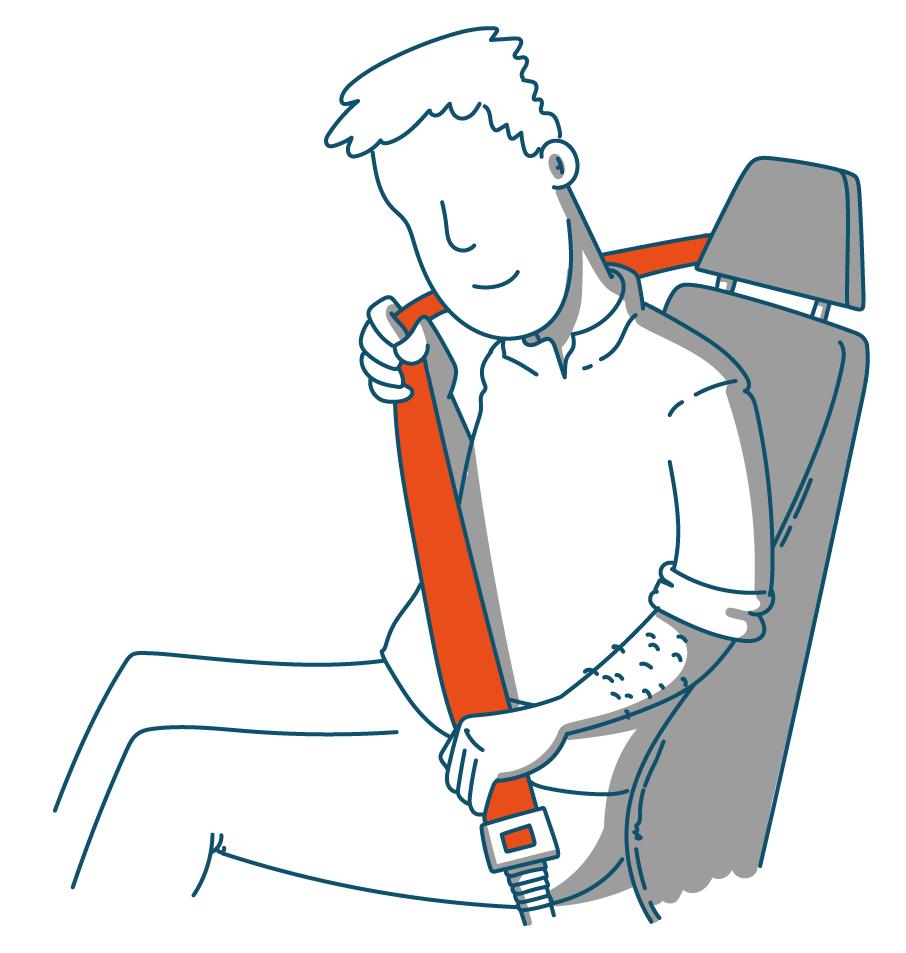
• A driver who is reversing, or supervising a learner driver who is reversing.

• In a vehicle being used for police, fire, and rescue services.
• A passenger in a trade vehicle investigating a fault.
• Driving a goods vehicle on deliveries that is travelling no more than 50 metres between stops.
• A licensed taxi driver who is ‘plying for hire’ or carrying passengers. Visit www.gov.uk for exemptions to wearing seat belts
Should a doctor say a seat belt does not need to be worn for a medical reason, they will issue a ‘Certificate of Exemption from Compulsory Seat Belt Wearing’. This must be kept in the vehicle and shown to the Police if stopped.

Did you know?
• Penalties for speeding range from £100 - £2,500 and between 3 and 6 penalty points.
• Drivers who go to court for speeding, could be fined up to 175% of their weekly salary and even be disqualified from driving.
• Speeding fines vary for certain types of roads and for different vehicle ratings.

50 60 60 70

Many van drivers are not aware that speed limits for most light commercial vehicles (LCVs) are lower than passenger cars on carriageways.
As a rule, the UK speed limit for vans is 10 mph slower than the maximums for cars.
Speed limits for vans are lower due to vans often weighing more than passenger cars and having a higher centre of gravity, which means the stopping distances are greater. They are not as easy to control and they can inflict greater damage on other vehicles.
Some local councils will implement different speed limits. Keep an eye out for any signs that might indicate this.
3 top tips to avoid speeding:
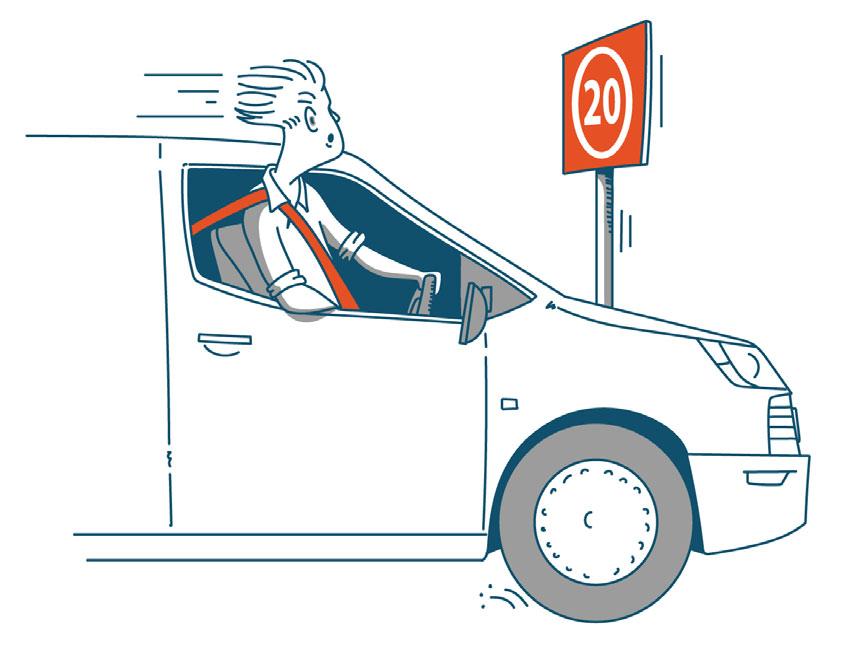
• Use cruise control, especially on motorways.
• Do not rely on the satnav, as they often display incorrect speed limits.
• Use a speed limiter to set a maximum speed limit.
Van drivers should be aware that the speed limit drops on motorways if they are towing.
Half of all vans fail their MOT at the first attempt.
The police and DVSA have the power to carry out spot checks on vehicles and can stop a vehicle being used if a prohibition is issued.
It is the driver’s responsibility to ensure the vehicle is safe and roadworthy.
Fine up to £2500
Two thirds of vans stopped at the roadside by the DVSA have a serious mechanical defect.

If a vehicle is overloaded, the driver can be given an immediate prohibition notice.
A driving ban 3 penalty points
Fines must be paid by the driver at the roadside or by phone or post after receiving penalty letter.
Drivers are required to check the condition of their van every day and report any defects in writing to the owner. Pre-use walk around checks can be recorded on paper or electronically. Visit www.gov.uk and search for ‘van driver daily walkaround check’.


• Secure wheel fixings, bodywork and doors.
• All lights and brakes work.
• No fuel or oil leaks.
• Sufficient tyre pressure and tread depth.
• Tyres are free of cuts and defects.

• Clean and undamaged windscreen, windows and mirrors.
• Operational washers, wipers and horn.
• No excessive play in the steering.
• Secure tow bar/trailer coupling.
• Load and tools are to be secure on the vehicle.
Roadworthy means a vehicle is in a suitable operating condition and meeting accepted standards for safe driving on the road. The Highway Code states drivers must ensure their vehicle complies with the full requirements of the Road Vehicles (Construction and Use) Regulations and Road Vehicles Lighting Regulations.
Drivers must ensure their vehicle is safe to drive before setting off on a journey.
They should carry out a walkaround check of the vehicle. Daily vehicle checks are a simple and effective way to identify potentially dangerous defects before vehicles are used.
There is no set time required to complete a vehicle check, drivers should ensure they take sufficient time for the size and type of their van.
• Drivers in England, Wales and Scotland convicted of causing death by careless driving when under the influence of drink or drugs face a minimum period of disqualification of 5 years and the maximum penalty of life imprisonment.
• A driver could be charged with driving while unfit even if they are not over the limit.
• The only thing that eliminates alcohol from the body is time and the average person will metabolise around 1 unit of alcohol per hour.
A drink drive conviction means...
a mandatory driving ban for at least 1 year (3 years if convicted twice in 10 years).
You could also be given:
• 6 months in prison.
• an unlimited fine.
A conviction for drink driving also means: an offence which stays on your licence for 11 years

a big increase in vehicle insurance.
difficulty travelling to countries like the USA.
an employer will see the conviction on the driving licence.
Drinking alcohol affects a driver’s eye, hand, and foot coordination. It impairs reaction time, coordination concentration, decreases vision and inhibits judgement.
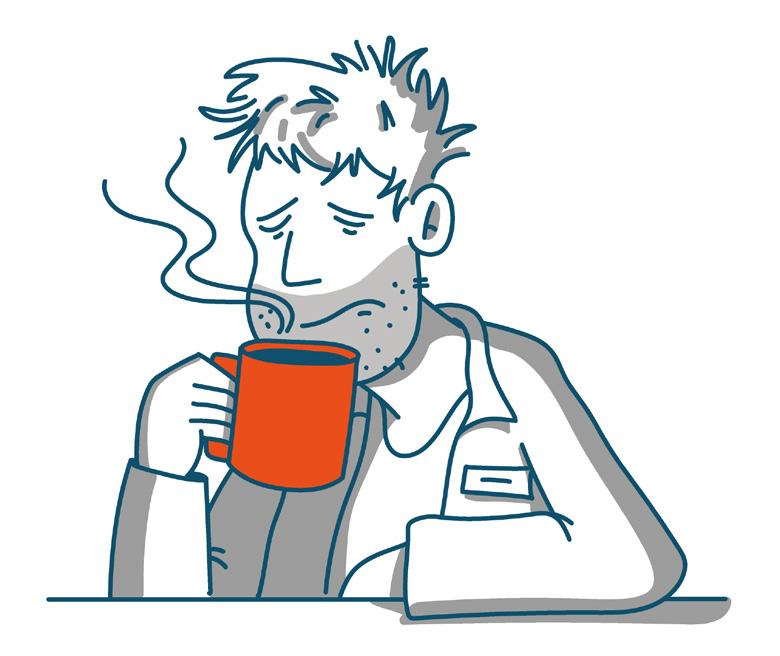
The Road Traffic Act 1988 identifies that a person who, when driving or attempting to drive a mechanically propelled vehicle on a road or other public place, is unfit to drive through drink or drugs, is guilty of an offence.
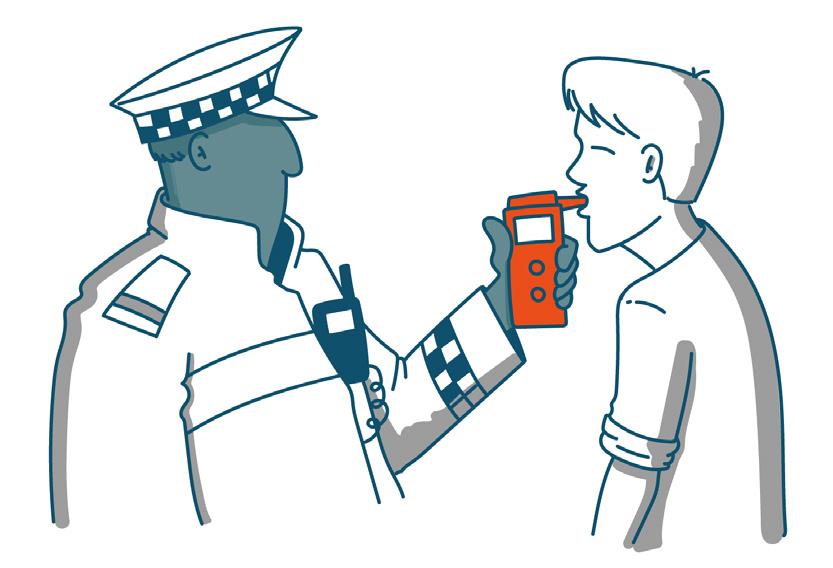
There are strict alcohol limits for drivers, and remember the limits in Scotland are lower than the rest of the UK.
from the bloodstream.

The “Morning after” effect means you could still be over the limit and your driving affected the next day as it takes time for alcohol to be eliminated
A good night’s sleep followed by a fry-up and strong coffee DOES NOT SPEED THIS UP!
• 1 in 5 collisions are caused by tiredness.
• Peak times for fatigue-related collisions are within the hours of 02.00-06.00 and 14.00-16.00.
• Sleeping just 4-5 hours a night for a week impairs performance to the same extent as being legally over the alcohol limit.
83% of van drivers feel more tired in the autumn and winter.
1 in 5 people suffer some form of sleep problem affecting their driving ability by impairing coordination, judgment ability and memory and causing longer reaction times.
Whilst driving when tired is not an offence, it does increase the chance of drivers committing other driving related offences or causing a serious or fatal collision.
A driver who is awake for 24 hours is 7 times more likely to have an accident.

• Have adequate sleep before starting your journey.
• Avoid heavy meals before starting driving.
• Plan a 15-minute break for every two hours of driving.
• Avoid taking medication that causes drowsiness.

• Stop in a safe place and take a break at the first sign of tiredness.
• Drink two cups of coffee or an equivalent caffeinated drink.
• Take a short nap of around 15-20 minutes.
Driving when tired or unwell impairs judgement and reaction time causing drivers to react slowly, brake late and is a major factor in a lot of rear end incidents. It also affects coordination resulting in a variance in speedslowing down and speeding up. Tired drivers also have what is known as microsleeps, which last from a fraction of a second to 2 seconds. At 56mph a van travels 25m/sec, so microsleeping for 2 seconds means 50m of unconscious travel.

Motorways and dual carriageways are the most common roads for sleeprelated road incidents, due to the monotonous road environment and lack of interruptions. Crashes caused by drivers falling asleep involve vehicles running off the road or into the back of another vehicle. They tend to be high-speed impact incidents and the risk of death or serious injury is high.

• It is an offence to drive having over the specified limits of certain drugs in the blood.
• Drivers in England, Wales and Scotland convicted of causing death by careless driving when under the influence of drink or drugs face a minimum period of disqualification of 5 years and the maximum penalty of life imprisonment.
• Driving while impaired by drugs is thought to be a major contributor to death and injury on the roads.

Drugs that act on the central nervous system can impair many functions associated with individuals’ abilities to drive safely.
43.6% of fatally injured drivers each year test positive for drugs and over 50% of those are positive for two or more drugs.
Drug driving puts people at a higher risk for road incidents. The Road Traffic Act 1988 created an offence of driving a motor vehicle while the concentration of any specified drug in the blood is above a limit set for that drug.
Police can stop and request a driver does a ‘field impairment assessment’ if they think the driver is on drugs. They can also use a roadside drug kit to screen for cannabis and cocaine. Even drivers that pass the roadside check can be arrested if the police suspect that your driving is impaired by drugs.
Driving, or attempting to drive, while over the limit or while under the influence of drugs will result in:
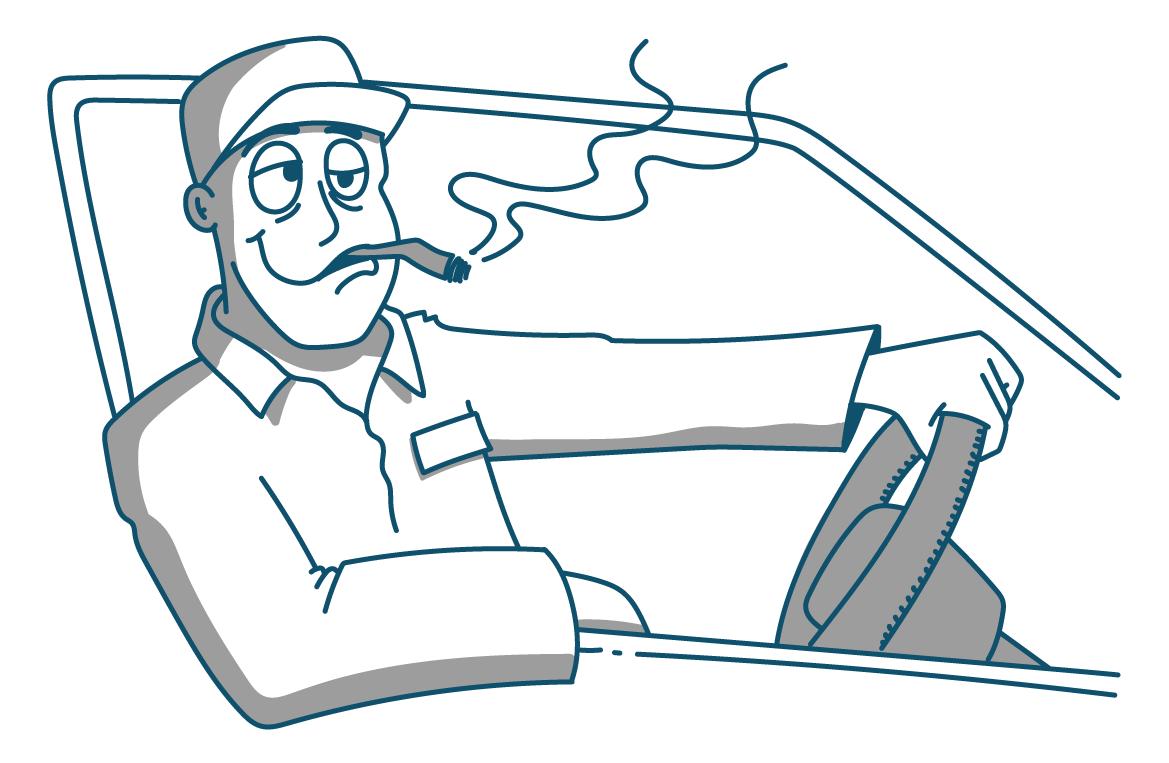
• a minimum 1-year driving ban.
• an unlimited fine.
• up to 6 months in prison.
• a criminal record.
• an offence which stays on the licence for 11 years.
• possibly loss of vehicle.
Prescribed medication, and over the counter medication such as cold remedies, must be checked with a doctor to ensure it does not contain banned substances causing a driver to be unfit to drive. A conviction for drug driving also means:
• a significant increase in vehicle insurance costs.
• an employer will see the conviction on the driving licence.
• having trouble travelling to countries like the USA.
The government have taken a zero-tolerance approach when setting the maximum legal limits of 8 drugs that are mostly associated with illegal use.

Benzoylecgonine
Cocaine
Cannabis
Ketamine
LSD/Acid
Methamphetamine
MDMA
Heroin
The government have taken a risk-based approach when setting the maximum legal limits of 8 drugs that are mostly associated with medical use.

clonazepam
diazepam
flunitrazepam
lorazepam
methadone
morphine
oxazepam
temazepam

• Drivers can be fined up to £1,000 if they do not inform DVLA about a medical condition that affects their driving.
• It is an offence for drivers to refuse to submit to an eyesight test when requested to by the police.
• Drivers may be prosecuted if involved in a collision because of their known medical condition.
Before driving any vehicle, the driver is legally required to ensure they meet the minimum eyesight rules.
YOUR REG 20m
The Road Traffic Act 1988 creates the offence of driving with ‘uncorrected defective eyesight’ and drivers could be prosecuted if they drive without meeting the standards of vision for driving.
Drivers must be able to read a vehicle number plate made after 1st Sept 2001 from 20 metres (with glasses or contact lenses, if necessary).
There are medical conditions that could affect the ability to drive safely. Drivers are legally responsible for informing DVLA if they have a driving licence and develop a ‘notifiable’ medical condition or disability. Also, a condition or disability that has got worse since they got their licence.


Notifiable conditions are anything that could affect the ability to drive safely.
Visit www.gov.uk and search for ‘driving medical conditions’

Drivers must wear glasses or contact lenses every time they drive if they need them to meet the ‘standards of vision for driving’.
Drivers must tell DVLA of any problem with their eyesight that affects both of their eyes, or the remaining eye if they only have one eye. This does not include being short or long sighted or colour blindness.
Drivers must give up their licence if the doctor tells them to stop driving for 3 months or more, or if they do not meet the required standards for driving because of a medical condition.
Drivers can apply to get their licence back when they meet the medical standards for driving again.
• 56% of van drivers consider themselves overweight.

• 70% of van drivers say work pressures severely impact their ability to drink enough water and have a healthy diet.
• Suicide is the biggest killer of men under 45 in the UK, with 1 man dying every two hours.
27% of van drivers rely solely on sugary drinks or caffeine to get them through the day.


Only 76% of drivers take a lunch break and
41% eat their lunch in their van.
37% eat at least 1 portion of fruit or vegetables during the working day.
The recommended fluid intake per day for is 2.5 litres for men and 2 litres for women.

Isolation, increased time pressures, stress and road congestion have a known detrimental effect on the mental health of van drivers.

Every week 125 people in the UK take their own lives and 75% of all UK suicides are male.
Talking about our feelings can be difficult at first but should be encouraged for driver well-being.
• Tell someone when you are not feeling fine or having a tough day/week.
• Make time to listen to someone you know that appears down or distracted.
Regular exercise improves mood and increases endorphins in the system. Try running, swimming, cycling, weights or even just a good walk!

• Trust your instincts.
• Share information and resources and support.
• Regular and sufficient sleep reduces worry.
• Make a note of things that are worrying you as it will help to address them.
• Every day, take a moment to think of one positive, good thing in your life.
Van drivers have a busy job and need to maintain high levels of concentration all day. Being well hydrated is particularly important for both physical health and mental performance. Drivers can experience fatigue or become less alert when dehydrated. Dehydration can be driven by air conditioning and hot, protective clothing. Many van drivers do not take the recommended liquid intake during the day, partly due to the lack of toilet facilities. Simple, small changes to meals and snacks can make a huge difference to diet and health.

Water is the healthiest way to hydrate as it contains no sugar or calories. A handful of nuts or a piece of fruit is a great alternative to a bag of crisps. Wholemeal bread and bananas provide a slow-release energy though the day.
0800 58 58 58 or thecalmzone.net/help 5pm - midnight, every day
Free